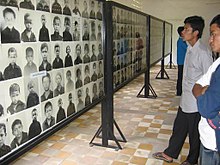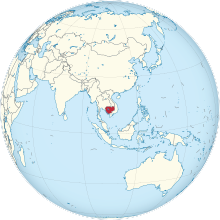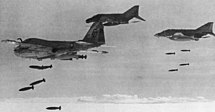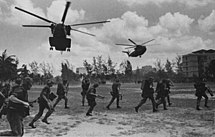ব্যবহারকারী:Rezwan Khair/খেলাঘর
কাম্পুচিয়া রাজ্য
| |
|---|---|
নীতিবাক্য: ជាតិ សាសនា ព្រះមហាក្សត្រ Chéatĕ, Sasnéa, Preăh Môhaksâtr “জাতি, ধর্ম, রাজা” | |
জাতীয় সঙ্গীত: បទនគររាជ Nôkôr Réach “মহিমান্বিত রাজ্য” | |
| রাজধানী ও বৃহত্তম নগরী বা বসতি | নম পেন ১১°৩৩′ উত্তর ১০৪°৫৫′ পূর্ব / ১১.৫৫০° উত্তর ১০৪.৯১৭° পূর্ব |
| প্রচলিত ভাষা | ফরাসি[১] |
| দাফতরিক ভাষা ও রাষ্ট্রভাষা | খ্মের[২] |
| দাফতরিক লিপি | খ্মের[২] |
| নৃগোষ্ঠী (২০১৯) |
|
| ধর্ম (২০১৯) |
|
| জাতীয়তাসূচক বিশেষণ |
|
| সরকার | এককেন্দ্রিক প্রভাবশালী-দলীয় সংসদীয় নির্বাচনী সাংবিধানিক রাজতন্ত্র |
• রাজা | নরোদম শিয়ামনি |
• প্রধানমন্ত্রী | হুন সেন |
• জাতীয় সংসদের সভাপতি | হেং সাম্রিন |
• সিনেটের সভাপতি | সায় ছুম |
| আইন-সভা | আইনসভা |
• উচ্চকক্ষ | সিনেট |
• নিম্নকক্ষ | জাতীয় সংসদ |
| স্বাধীনতা ফ্রান্সের কাছ থেকে | |
• ফরাসি আশ্রিত রাজ্য | ১১ অগাস্ট ১৮৬৩ |
• স্বাধীনতা | ৯ নভেম্বর ১৯৫৩ |
| আয়তন | |
• মোট | ১,৮১,০৩৫ কিমি২ (৬৯,৮৯৮ মা২) (৮৮শ) |
• পানি (%) | ২.৫ |
| জনসংখ্যা | |
• ২০২১ আনুমানিক | |
• ঘনত্ব | ৮৭/কিমি২ (২২৫.৩/বর্গমাইল) (৯৬শ) |
| জিডিপি (পিপিপি) | ২০১৯ আনুমানিক |
• মোট | $৭৬.৬৩৫ বিলিয়ন[৭][পূর্ণ তথ্যসূত্র প্রয়োজন] |
• মাথাপিছু | $৪,৬৪৫[৭] |
| জিডিপি (মনোনীত) | ২০১৯ আনুমানিক |
• মোট | $২৬.৬২৮ বিলিয়ন[৭] |
• মাথাপিছু | $১,৬১৪[৭] |
| জিনি (১০১৩) | ৩৬.০[৮] মাধ্যম |
| মানব উন্নয়ন সূচক (২০১৯) | ০.৫৯৪[৯] মধ্যম · ১৪৪শ |
| মুদ্রা |
|
| সময় অঞ্চল | ইউটিসি+০৭:০০ (ইচীস) |
| তারিখ বিন্যাস | দদ/মম/সসসস |
| গাড়ী চালনার দিক | ডান |
| কলিং কোড | +৮৫৫ |
| ইন্টারনেট টিএলডি | .kh |
কম্বোডিয়া (/kæmˈboʊdiə/ (ⓘ))[১২] বা কাম্পুচিয়া (/ˌkæmpʊˈtʃiːə/; খ্মের: កម្ពុជា, Kâmpŭchéa [ˈkampuciə]), যার দাফতরিক নাম কাম্পুচিয়া রাজ্য, হল দক্ষিণ-পূর্ব এশিয়ার ইন্দোচীন উপদ্বীপের দক্ষিণাঞ্চলে অবস্থিত একটি দেশ। এর আয়তন ১,৮১,০৩৫ বর্গকিলোমিটার (৬৯,৮৯৮ বর্গমাইল) এবং দেশটির উত্তর-পশ্চিমে থাইল্যান্ড, উত্তরে লাওস, পূর্বে ভিয়েতনাম এবং দক্ষিণ-পশ্চিমে থাইল্যান্ড উপসাগর অবস্থিত। কম্বোডিয়ায় দুই ঋতুসম্পন্ন একটি গ্রীষ্মমণ্ডলীয় মৌসুমী জলবায়ু রয়েছে এবং দেশটি টোনলে সাপ হ্রদ ও মেকং বদ্বীপের চারপাশে একটি কেন্দ্রীয় প্লাবনভূমি নিয়ে গঠিত, যা পাহাড়ি অঞ্চল দ্বারা বেষ্টিত। দেশটির রাজধানী ও বৃহত্তম শহর নম পেন।
সার্বভৌম কম্বোডিয়া রাষ্ট্রের জনসংখ্যা ১৭ মিলিয়নেরও বেশি।[১৩] সংবিধানে বৌদ্ধধর্মকে দাফতরিক রাষ্ট্রধর্ম হিসেবে অন্তর্ভুক্ত করা হয়েছে এবং জনসংখ্যার ৯৭ শতাংশেরও বেশি এটি অনুশীলন করে।[১৪] কম্বোডিয়ার সংখ্যালঘু জনগোষ্ঠীর মধ্যে ভিয়েতনামি, চীনা, চাম ও ৩০টি পাহাড়ি উপজাতি অন্তর্ভুক্ত রয়েছে।[১৫] রাজধানী ও বৃহত্তম শহর নম পেন হল কম্বোডিয়ার রাজনৈতিক, অর্থনৈতিক ও সাংস্কৃতিক কেন্দ্র। রাজ্যটি হল একটি নির্বাচনী সাংবিধানিক রাজতন্ত্র যার একজন সম্রাট, বর্তমানে নরোদম শিহামনি, সিংহাসনের রাজকীয় পরিষদ কর্তৃক রাষ্ট্রপ্রধান হিসাবে নির্বাচিত হন। সরকারপ্রধান হলেন প্রধানমন্ত্রী, বর্তমানে হুন সেন, দক্ষিণ-পূর্ব এশিয়ার সবচেয়ে দীর্ঘকালীন অরাজকীয় নেতা, যিনি ১৯৮৫ সাল থেকে শাসন করেছেন।
প্রাচীনকাল থেকেই কম্বোডিয়াতে রাজতন্ত্র বিদ্যমান ছিল। এক হাজার বছরেরও আগে কম্বোডিয়া খমের জাতির আংকর সাম্রাজ্যের কেন্দ্র ছিল। আংকর সাম্রাজ্যটি ৬০০ বছর ধরে সমগ্র দক্ষিণ-পূর্ব এশিয়া জুড়ে বিস্তৃত ছিল। ১৮৬৩ থেকে ১৯৫৩ সাল পর্যন্ত এটি একটি ফরাসি প্রোটেক্টোরেট ছিল। ১৯৭০ সালে রাজতন্ত্রের স্থানে প্রজাতন্ত্র প্রতিষ্ঠা করা হয় এবং ১৯৭৫ সালে খমের রুজ নামের একটি সাম্যবাদী সরকার ক্ষমতা লাভ করে। তারা দেশটিকে গণতন্ত্রী কাম্পুচিয়া নাম দেয়। খমের রুজের নিপীড়ন এবং চরমপন্থী সমাজতান্ত্রিক সংস্কার কম্বোডিয়ার সমাজ ও অর্থনীতিতে ধ্স নামায়। ১৯৭৯ সালে ভিয়েতনাম ও কম্বোডিয়ার খমের রুজ-বিরোধী শক্তি সরকারটির পতন ঘটায় এবং অপেক্ষাকৃত সহিষ্ণু একটি সাম্যবাদী সরকার গঠন করে। ১৯৮৯ সালে দেশটি সমাজতন্ত্র পরিত্যাগ করে এবং ১৯৯৩ সালে একটি নতুন সংবিধান পাস করে রাজতন্ত্র পুনঃপ্রতিষ্ঠা করা হয়।
ইতিহাস
ফরাসী উপনিবেশকাল
থাইল্যান্ডের রত্তানাকোসিন রাজ্য যা শ্যাম নামেও পরিচিত (যেকারণে থাইল্যান্ডকে শ্যামদেশ বলা হতো) রাজা নরোদমকে কম্বোডিয়ার ক্ষমতায় বসায়।[১৬] কিন্তু ১৮৬৩ সালে নরোদম শ্যামদের থেকে রক্ষা পাবার জন্য ফ্রান্সের কাছে নিরাপত্তা প্রার্থনা করেন। ১৮৬৭ সালে শ্যাম রাজা চতুর্থ রাম ফ্রান্সের সাথে একটি চুক্তি স্বাক্ষর করে কম্বোডিয়ার বৈদেশিক সম্পর্ক নিয়ন্ত্রনের ক্ষমতা (সুজেরাইনটি) তাদের হাতে তুলে দেন। বিনিময়ে তিনি বাটামবাং এবং সিয়েম রিপ প্রদেশদুটিকে অফিশিয়ালি শ্যামদেশের অংশ হিসেবে যুক্ত করে ফেলেন। ১৯০৭ সালে অবশ্য ফ্রান্স এবং শ্যামদেশের আরেকটি চুক্তির মাধ্যমে প্রদেশদুটি কম্বোডিয়া ফেরত পায়।
১৮৬৭ থেকে ১৯৫৩ সাল পর্যন্ত কম্বোডিয়া ফ্রান্সের প্রটেকটরেট রাজ্য হিসেবেই ছিল, ফরাসি ইন্দোচীন উপনিবেশের অংশ হিসেবেই এর প্রশাসনিক কার্যক্রম সম্পন্ন হতো। তবে মাঝে ১৯৪১ থেকে ১৯৪৬ পর্যন্ত কম্বোডিয়া ছিল জাপানের দখলে[১৭] এবং ১৯৪৫ এর মধ্যভাগে খুব অল্প সময়ের জন্য কাম্পুচিয়া রাজ্যের পুতুল রাষ্ট্ররূপে। ১৮৭৪ থেকে ১৯৬২ সালের মধ্যে মোট জনসংখ্যা ৯,৪৬,০০০ থেকে বেড়ে দাঁড়ায় ৫৭ লক্ষ।[১৮] ১৯০৪ সালে রাজা নরোদমের মৃত্যু হলে ফরাসীরা নতুন রাজা নির্বাচনে তাদের প্রভাব খাটায় এবং নরোদমের ভাই সিসোয়াথকে সিংহাসনে বসানো হয়। ১৯২৭ সালে সিসোয়াথের মৃত্যুর পর তার ছেলে সিসোয়াথ মনিভং ক্ষমতায় আসেন। ১৯৪১ সালে মনিভংয়ের মৃত্যুর পর তার ছেলে মনিরেথের হবার কথা থাকলেও ফরাসীদের মত ছিল মনিরেথ বেশি স্বাধীনচেতা, তাই তার বদলে নরোদম সিহানুককে তারা সিংহাসনে বসায়। সিহানুক ছিলেন রাজা সিসোয়াথের দৌহিত্র। ফরাসীরা ভেবেছিল এই তরুণ রাজাকে তারা সহজেই নিজেদের মতো চালাতে পারবে।[১৭] কিন্তু সেই আশা ব্যর্থতায় পর্যবসিত হয়। বরং রাজা নরোদম সিহানুকের আমলেই ফ্রান্সের কাছ থেকে কম্বোডিয়া স্বাধীনতা লাভ করে, ৯ই নভেম্বর ১৯৫৩ সালে।[১৭]
স্বাধীনতা এবং ভিয়েতনাম যুদ্ধ
রাজা নরোদম সিহানুকের অধীনে কম্বোডিয়া একটি সাংবিধানিক রাজতন্ত্রে রূপলাভ করে। যখন ফরাসি ইন্দোচীন স্বাধীন হয়, কম্বোডিয়া মেকং বদ্বীপের দখল পাবার আশা ছেড়ে দেয় কারণ এটি তখন ভিয়েতনামকে দেওয়া হয়ে গেছে।[তথ্যসূত্র প্রয়োজন] মেকং ছিল একসময় খেমের রাজ্যের অংশ, পরে ১৬৯৮ সাল থেকে এটি ভিয়েতনামীদের দখলে চলে যায়;[১৯] রাজা ২য় চেয় চেত্থা অবশ্য আরো কয়েক দশক আগে থেকেই ভিয়েতনামীদের সেখানে বসতি স্থাপন করবার অনুমতি দিয়েছিলেন।[২০] কিন্তু তখনো দশ লাখের বেশি খেমের জাতিগোষ্ঠীর মানুষ সেখানে বসবাস করতে থাকায় এটি একটি কূটনৈতিক সমস্যা হয়ে দাড়াঁয়। পরবর্তীতে খেমের রুজরা অঞ্চলটা পুনরুদ্ধারের জন্য আক্রমণ চালিয়েছিল, কিন্তু ভিয়েতনাম তখন পাল্টা কম্বোডিয়ায় আগ্রাসন চালিয়ে খেমের রুজকেই উৎখাত করে দেয়।

১৯৫৫ সালে সিহানুক রাজনীতিতে অংশ নেওয়ার জন্য তার বাবাকে সিংহাসন ছেড়ে দেন এবং প্রধানমন্ত্রী নির্বাচিত হন। কিন্তু ১৯৬০ সালে বাবার মৃত্যুর পর তিনি আবার রাষ্ট্রপ্রধান হয়ে যান এবং তখন প্রিন্স উপাধি নেন। ভিয়েতনাম যুদ্ধ যখন চলছে এবং সময়টা স্নায়ুযুদ্ধের, সিহানুক নিরপেক্ষ থাকার নীতি গ্রহণ করেন। তিনি ভিয়েতনামী কমিউনিস্টদের কম্বোডিয়াকে আশ্রয় হিসেবে ব্যবহার করায় বাধা দেননি যারা কিনা কম্বোডিয়ার মধ্য দিয়ে দক্ষিণ ভিয়েতনামে তাদের যোদ্ধাদের কাছে অস্ত্রশস্ত্র এবং অন্যান্য সহযোগিতা পাঠাতো। অনেক কম্বোডীয়রা রাজার এই নীতিকে অপমানসূচক মনে করতে থাকে। সিহানুক ১৯৬৭ সালের ডিসেম্বরে ওয়াশিংটন পোস্টের সাংবাদিক স্ট্যানলি কার্নোউকে বলেন যে মার্কিন যুক্তরাষ্ট্র যদি কম্বোডিয়ায় আশ্রয় লুকিয়ে থাকা ভিয়েতনামী কমিউনিস্টদের আস্তানায় বোমা মারতে চায় তার আপত্তি নেই যতক্ষণ না কম্বোডীয়রা মারা যাচ্ছে।[২১]
মার্কিন প্রেসিডেন্ট জনসনের দূত চেস্টার বোলেসকেও তিনি একই কথা বলেন ১৯৬৮-এর জানুয়ারিতে।[২২] কিন্তু জনসম্মুখে তিনি কম্বোডিয়ায় আমেরিকার বিমান আক্রমণের অধিকার অস্বীকার করেন এবং ২৬শে মার্চ বলেন যে "এই অপরাধমূলক আক্রমণ এক্ষুণি সম্পূর্ণরূপে বন্ধ করতে হবে।" ২৮শে মার্চ একটি সংবাদ সম্মেলন হয় এবং সিহানুক আন্তর্জাতিক সংবাদমাধ্যমের কাছে আবেদন জানান: "আমি আপনাদের আহ্বান জানাচ্ছি বিদেশে কম্বোডিয়ার এই অবস্থান জানানোর জন্য যে, আমি সর্বাবস্থায়, যে কারণেই হোক না কেন, কম্বোডিয়ার টেরিটরিতে বোমাবর্ষণের বিরোধিতা করছি।" তারপরেও সিহানুকের আবেদন অগ্রাহ্য করা হয় এবং বোমাবর্ষণ চলতে থাকে।[২৩] সরকারের এবং সেনাবাহিনীর সদস্যরা সিহানুকের শাসনপদ্ধতির প্রতি বীতশ্রদ্ধ হয়ে উঠতে থাকে। মার্কিন যুক্তরাষ্ট্রের দিক থেকে তার উলটো দিকে ঝুঁকে যাওয়াকেও তারা ভালো চোখে দেখছিল না।
খেমার প্রজাতন্ত্র (১৯৭০-৭৫)
১৯৭০ সালে সিহানুক বেইজিং সফরে থাকাকালে প্রধানমন্ত্রী জেনারেল লন নল এবং প্রিন্স সিসোয়াথ সিরিক মাতাক সামরিক অভ্যুত্থান করে ক্ষমতা দখল করে। মার্কিন যুক্তরাষ্ট্র এই অভ্যুত্থানে সহায়তা করেছিল কিনা তা প্রমাণিত হয়নি।[২৪] তবে অভ্যুত্থান সফল হওয়া মাত্রই নতুন শাসকেরা ভিয়েতনামী কমিউনিস্টদেরকে কম্বোডিয়া ত্যাগ করতে বলে, এতে তারা আমেরিকার রাজনৈতিক সমর্থন পায়। উত্তর ভিয়েতনামী এবং ভিয়েতকং সেনারা তাদের আশ্রয়স্থল এবং সরবরাহ লাইন চালু রাখার জন্য নতুন সরকারের ওপর আক্রমণ চালানো শুরু করে। রাজা সিহানুকও এদিকে তার সমর্থকদের বলেন নতুন সরকারকে উৎখাত করতে সহযোগিতা করতে, ফলে কম্বোডিয়ার গৃহযুদ্ধ ত্বরান্বিত হয়।[২৫]
দ্রুতই খেমার রুজ বিপ্লবীরা তাদের পক্ষে সমর্থন পাওয়ার জন্য সিহানুককে ব্যবহার করতে শুরু করে। ১৯৭০ থেকে ১৯৭২ সালের প্রথমদিক পর্যন্ত কম্বোডিয়ার সংঘাত ছিল মূলত সরকার ও কম্বোডিয়ার সেনাবাহিনী এবং উত্তর ভিয়েতনামী সামরিক বাহিনীগুলোর মধ্যে। ভিয়েতনামী কমিউনিস্টরা কম্বোডিয়ার যেসব অঞ্চল দখল করছিল সেখানে নতুন রাজনৈতিক অবকাঠামো প্রবর্তন করছিল এবং পরবর্তীতে এই কাঠামোতে খেমার রুজ বলে কথিত কম্বোডীয় কমিউনিস্টরাই সর্বেসর্বা হয়ে ওঠে।[২৭] ১৯৬৯ থেকে ১৯৭৩ সালের মধ্যে ভিয়েত কং এবং খেমার রুজদের দমন করার জন্য ভিয়েতনাম প্রজাতন্ত্র এবং মার্কিন সেনাবাহিনী কম্বোডিয়ায় বিপুল বোমাবর্ষণ করে।
Documents uncovered from the Soviet archives after 1991 reveal that the North Vietnamese attempt to overrun Cambodia in 1970 was launched at the explicit request of the Khmer Rouge and negotiated by Pol Pot's then second in command, Nuon Chea.[২৮] NVA units overran many Cambodian army positions while the Communist Party of Kampuchea (CPK) expanded their small-scale attacks on lines of communication. In response to the North Vietnamese invasion, US President Richard Nixon announced that US and South Vietnamese ground forces had entered Cambodia in a campaign aimed at destroying NVA base areas in Cambodia (see Cambodian Incursion).[২৯] Although a considerable quantity of equipment was seized or destroyed by US and South Vietnamese forces, containment of North Vietnamese forces proved elusive.
The Khmer Republic's leadership was plagued by disunity among its three principal figures: Lon Nol, Sihanouk's cousin Sirik Matak, and National Assembly leader In Tam. Lon Nol remained in power in part because neither of the others was prepared to take his place. In 1972, a constitution was adopted, a parliament elected, and Lon Nol became president. But disunity, the problems of transforming a 30,000-man army into a national combat force of more than 200,000 men, and spreading corruption weakened the civilian administration and army.
The Communist insurgency inside Cambodia continued to grow, aided by supplies and military support from North Vietnam. Pol Pot and Ieng Sary asserted their dominance over the Vietnamese-trained communists, many of whom were purged. At the same time, the CPK forces became stronger and more independent of their Vietnamese patrons. By 1973, the CPK were fighting battles against government forces with little or no North Vietnamese troop support, and they controlled nearly 60% of Cambodia's territory and 25% of its population. The government made three unsuccessful attempts to enter into negotiations with the insurgents, but by 1974, the CPK were operating openly as divisions, and some of the NVA combat forces had moved into South Vietnam. Lon Nol's control was reduced to small enclaves around the cities and main transportation routes. More than 2 million refugees from the war lived in Phnom Penh and other cities.
On New Year's Day 1975, Communist troops launched an offensive which, in 117 days of the hardest fighting of the war, led to the collapse of the Khmer Republic. Simultaneous attacks around the perimeter of Phnom Penh pinned down Republican forces, while other CPK units overran fire bases controlling the vital lower Mekong resupply route. A US-funded airlift of ammunition and rice ended when Congress refused additional aid for Cambodia. The Lon Nol government in Phnom Penh surrendered on 17 April 1975, just five days after the US mission evacuated Cambodia.[৩০]
Khmer Rouge regime, 1975–1978


The Khmer Rouge reached Phnom Penh and took power in 1975. Led by Pol Pot, they changed the official name of the country to Democratic Kampuchea. The new regime modelled itself on Maoist China during the Great Leap Forward, immediately evacuated the cities, and sent the entire population on forced marches to rural work projects. They attempted to rebuild the country's agriculture on the model of the 11th century, discarded Western medicine, and destroyed temples, libraries, and anything considered Western.
Estimates as to how many people were killed by the Khmer Rouge regime range from approximately one to three million; the most commonly cited figure is two million (about a quarter of the population).[৩১][৩২][৩৩] This era gave rise to the term Killing Fields, and the prison Tuol Sleng became notorious for its history of mass killing. Hundreds of thousands fled across the border into neighbouring Thailand. The regime disproportionately targeted ethnic minority groups. The Cham Muslims suffered serious purges with as much as half of their population exterminated.[৩৪] Pol Pot was determined to keep his power and disenfranchise any enemies or potential threats, and thus increased his violent and aggressive actions against his people.[৩৫]
Forced repatriation in 1970 and deaths during the Khmer Rouge era reduced the Vietnamese population in Cambodia from between 250,000 and 300,000 in 1969 to a reported 56,000 in 1984.[১৮] However, most of the victims of the Khmer Rouge regime were not ethnic minorities but ethnic Khmer. Professionals, such as doctors, lawyers and teachers, were also targeted. According to Robert D. Kaplan, "eyeglasses were as deadly as the yellow star" as they were seen as a sign of intellectualism.[৩৬]
Religious institutions were targeted by the Khmer Rouge particularly fiercely. Religion was so viciously persecuted to such a terrifying extent that the vast majority of Cambodia's historic architecture, 95% of Cambodia's Buddhist temples, was completely destroyed.[৩৭]
Vietnamese occupation and transition, 1978–1992
In November 1978, Vietnamese troops invaded Cambodia in response to border raids by the Khmer Rouge.[৩৮] The People's Republic of Kampuchea (PRK), a pro-Soviet state led by the Kampuchean People's Revolutionary Party, a party created by the Vietnamese in 1951, and led by a group of Khmer Rouge who had fled Cambodia to avoid being purged by Pol Pot and Ta Mok, was established.[স্পষ্টকরণ প্রয়োজন][৩৯] It was fully beholden to the occupying Vietnamese army and under the direction of the Vietnamese ambassador to Phnom Penh. Its arms came from Vietnam and the Soviet Union.[৪০]
In opposition to the newly created state, a government-in-exile referred to as the Coalition Government of Democratic Kampuchea (CGDK) was formed in 1981 from three factions.[৪০] This consisted of the Khmer Rouge, a royalist faction led by Sihanouk, and the Khmer People's National Liberation Front. Its credentials were recognised by the United Nations. The Khmer Rouge representative to the UN, Thiounn Prasith, was retained, but he had to work in consultation with representatives of the noncommunist Cambodian parties.[৪১][৪২] The refusal of Vietnam to withdraw from Cambodia led to economic sanctions[৪৩] by the US and its allies.[উল্লেখ করুন]
Peace efforts began in Paris in 1989 under the State of Cambodia, culminating two years later in October 1991 in a Paris Comprehensive Peace Settlement. The UN was given a mandate to enforce a ceasefire and deal with refugees and disarmament known as the United Nations Transitional Authority in Cambodia (UNTAC).[৪৪]
Modern Cambodia (1993–present)
In 1993, the monarchy was restored with Norodom Sihanouk reinstated as King, and the first post-war election was coordinated by UNTAC. The election was won by FUNCINPEC led by Sihanouk's son Ranariddh in a hung parliament. A power-sharing agreement was agreed with Ranariddh and Hun Sen of the Cambodian People's Party both simultaneously being co-Prime Ministers after the CPP threatened to secede part of the country if power was fully transferred to FUNCINPEC. The stability established following the conflict was shaken in 1997 by a coup d'état led by the co-Prime Minister Hun Sen, who ousted Ranariddh and other parties represented in the government and consolidated power for the CPP.[৪৫][৪৬] After its government was able to stabilize under Sen, Cambodia was accepted into the Association of Southeast Asian Nations (ASEAN) on 30 April 1999.[৪৭][৪৮] Norodom Sihamoni was crowned Cambodia's king in 2004 after his father Sihanouk's abdication.[৪৯]
During the late 1990s and early 2000s, reconstruction efforts progressed which led to some political stability through a multiparty democracy under a constitutional monarchy[১৪] although Sen's rule has been marred by human rights abuses and corruption.[৫০] Cambodia's economy grew rapidly in the 2000s and 2010s,[৫১] and it received considerable investment and infrastructure development support from China as part of its Belt and Road Initiative.[৫২]

A UN-backed war crimes tribunal, the Khmer Rouge Tribunal sought out to investigate crimes committed during the Democratic Kampuchea period and prosecute its leaders. However, Hun Sen has opposed extensive trials or investigations of former Khmer Rouge officials.[৫৩] In July 2010, Kang Kek Iew was the first Khmer Rouge member found guilty of war crimes and crimes against humanity in his role as the former commandant of the S21 extermination camp and he was sentenced to life in prison.[৫৪][৫৫] In August 2014, the tribunal sentenced Khieu Samphan, the regime's 83-year-old former head of state, and Nuon Chea, its 88-year-old chief ideologue, to life in prison on war crimes charges for their role in the country's terror period in the 1970s.[হালনাগাদ প্রয়োজন]
After the 2013 Cambodian general election, allegations of voter fraud from opposition party Cambodia National Rescue Party led to widespread anti-government protests that continued into the following year. The protests ended after a crackdown by government forces.[৫৬][৫৭]
The Cambodia National Rescue Party was dissolved ahead of the 2018 Cambodian general election and the ruling Cambodian People's Party also enacted tighter curbs on mass media.[৫৮] The CPP won every seat in the National Assembly without a major opposition, effectively solidifying de facto one-party rule in the country.[৫৯][৬০]
The global COVID-19 pandemic spread to Cambodia in early 2020. Despite minimising the disease's spread for much of 2020[৬১] the country's health system was put under strain by a major outbreak in early 2021, which prompted several lockdowns.[৬২] It also had a severe economic impact, with the tourism industry particularly affected due to international travel restrictions.[৬৩]
রাজনীতি
কম্বোডিয়ার রাজনীতি একটি সংসদীয় প্রতিনিধিত্বমূলক গণতান্ত্রিক রাজতন্ত্র কাঠামোয় সংঘটিত হয়। রাজা বা রাণী হলেন রাষ্ট্রের প্রধান। সরকারপ্রধান হলেন প্রধানমন্ত্রী। রাষ্ট্রের নির্বাহী ক্ষমতা সরকারের উপর ন্যস্ত। আইন প্রণয়নের ক্ষমতা দ্বিপাক্ষিক আইনসভার উপর ন্যস্ত।
প্রশাসনিক অঞ্চলসমূহ
ভূগোল

অর্থনীতি
কম্বোডীয় অর্থনীতি কৃষি নির্ভর।এখানে প্রচুর মাছ পাওয়া যায়।
জনমিতি
জনসংখ্যা
২০১৪ সালে কাম্বোডিয়া তে আনুমানিক ১৫,৪৫৮,৩৩২ লোক বসাবস করে।
ধর্ম
কম্বোডিয়ার ধর্ম (২০১৯ ওয়ার্ল্ড ফ্যাক্টবুক)[৬৪]

কম্বোডিয়ার সংবিধানের ৩য় অধ্যায়ের ৪৩শ অনুচ্ছেদ অনুসারে বৌদ্ধধর্ম দেশটির রাষ্ট্রধর্ম।[৬৫] ৯৫ শতাংশ কম্বোডীয় জনগণ থেরবাদ বৌদ্ধধর্মের অনুসারী এবং দেশজুড়ে আনুমানিক ৪,৩৯২টি বৌদ্ধবিহার ও মন্দির রয়েছে।[৬৬] কম্বোডীয় বৌদ্ধধর্ম গভীরভাবে হিন্দুধর্ম ও স্থানীয় সর্বপ্রাণবাদ দ্বারা প্রভাবিত।
আত্মা ও সম্প্রদায়ের মধ্যে ঘনিষ্ঠ আন্তঃসম্পর্ক, রক্ষক ও ভাগ্য-আকর্ষক ক্রিয়া ও আকর্ষণের কার্যকারিতা এবং ব্যারোমি আত্মা প্রভৃতি আধ্যাত্মিক সত্তাগুলির সাথে যোগাযোগের মাধ্যমে একজনের জীবন পরিচালনা করার সম্ভাবনা স্থানীয় লোকধর্ম থেকে উদ্ভূত। হিন্দুধর্ম তান্ত্রিকতাবাদের জাদুবিদ্যাচর্চার বাইরে সামান্য চিহ্ন রেখে গেছে এবং হিন্দু দেবতাদের একটি দল এখন আত্মিক জগতে আত্মীকৃত হয়েছেন। উদাহরণস্বরূপ, ইয়ে মাও নামক গুরুত্বপূর্ণ নেক তা আত্মা হলেন হিন্দু দেবী কালীর আধুনিক অবতার।
মহাযান বৌদ্ধধর্ম কম্বোডিয়ার অধিকাংশ চীনা ও ভিয়েতনামিদের ধর্ম। অন্যান্য ধর্মীয় অনুশীলনের উপাদান, যেমন লোকায়ত নায়ক ও পূর্বপুরুষদের পুজো, কনফুসীয়বাদ এবং চীনা বৌদ্ধধর্মের সঙ্গে তাওবাদের মিশ্রণও অনুশীলিত হয়।
প্রায় ২% জনগণ ইসলামের অনুসারী অনুসরণ এবং তাদের মধ্যে তিনটি প্রকারভেদ রয়েছে, দুটি চাম জাতির লোকেরা অনুশীলন করে এবং তৃতীয়টি মালয় বংশধরদের দ্বারা, যারা বংশ পরম্পরায় দেশটিতে বসবাস করে। কম্বোডিয়ার মুসলিম জনসংখ্যা ৮০% জাতিগত চাম বলে জানা গেছে।[৬৭]
সংস্কৃতি
আরও দেখুন
তথ্যসূত্র
বহিঃসংযোগ
বিষয়শ্রেণী:এশিয়ার রাষ্ট্রবিষয়শ্রেণী:দক্ষিণ-পূর্ব এশিয়ার দেশবিষয়শ্রেণী:১৯৫৩-এ প্রতিষ্ঠিত রাষ্ট্র ও অঞ্চলবিষয়শ্রেণী:১৯৯৩-এ প্রতিষ্ঠিত রাষ্ট্র ও অঞ্চল







